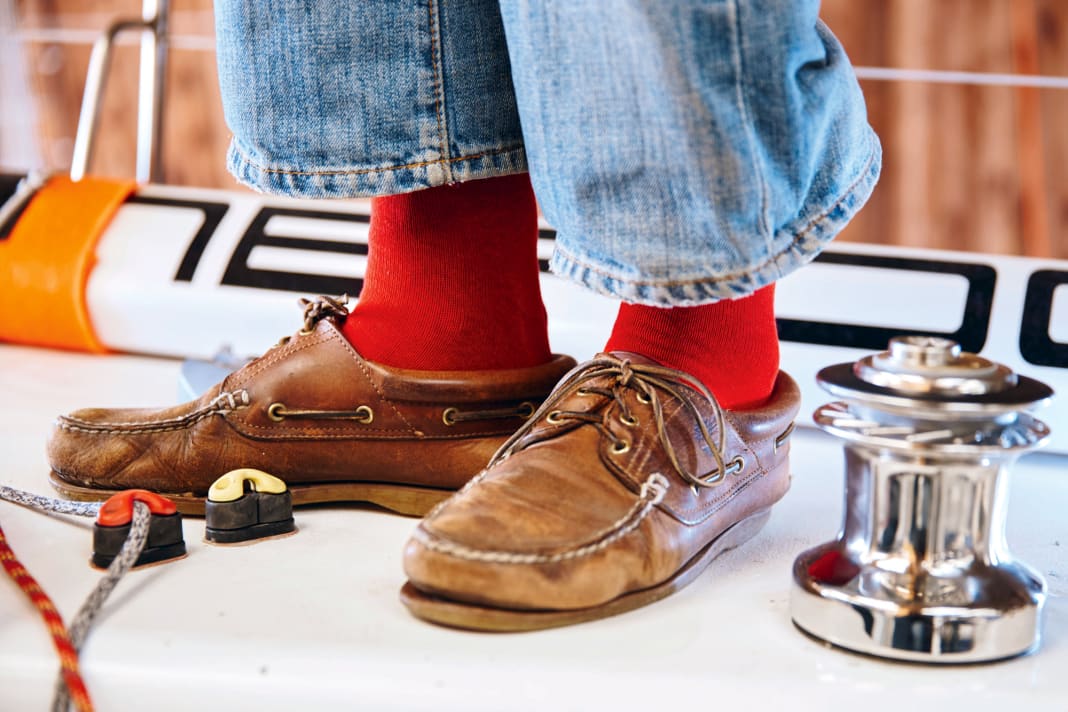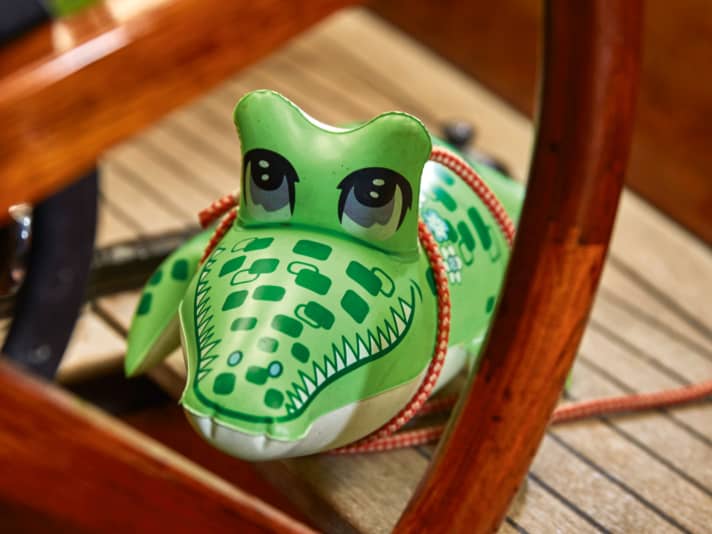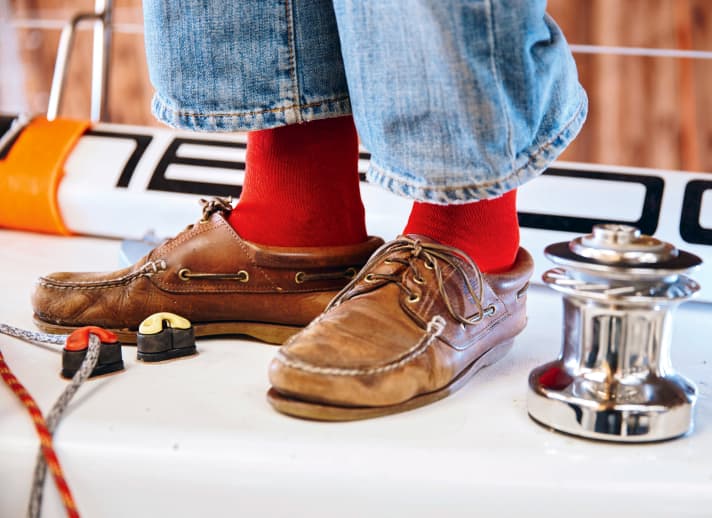Myths and rituals on board: What Friday the 13th, red socks and on-board animals mean






- Strange rituals do not a sailing original make
- On-board rituals boost morale
- On-board crocodile "Ollo" has its own cleat
- The mood after a hard day can be restored through rituals
- The ship is only clean when "Bilgo" appears
- Blake's red socks are legend
- Bible study in the doldrums on board the "Andromeda"
- Shosholoza not only stands for great performance, but also for sporting symbolism
"There are a lot of boring people sailing at sea today," Wolfgang J. Krauss begins his short story "Selling Out in Originals". He can say that. As the father of the sailor Gustav, Krauss is something of an expert when it comes to originals at sea. For many years, the author has put a smile on the faces of YACHT readers with Gustav's dull comments. And he lent a voice to that one-sided maritime world view that the mind rejects but the heart loves.
The story quoted at the beginning is about this very genre: "Where have all the quirky oddballs gone who were a constant source of conversation in my grandfather's day with their strange ships and often even stranger adventures?" asks Krauss. And then he talks about old Westhoff, a defence lawyer from Berlin in the 1920s.
Westhoff ignores the economic crisis by maintaining his pre-war lifestyle and travelling to the yacht club in Szczecin weekend after weekend in a Maybach with a chauffeur. There he boards his 20 metre long gaff ketch "Obotrit", whose brass fittings have been polished to a high shine during the week by the employed boatswain Juler.
Strange rituals do not a sailing original make
But an unworldly attempt to ignore reality does not make a sailing original. There is more to it on board. At sea, the individual system of ship, skipper and crew is characterised by rituals that are almost incomprehensible to outsiders. Habits that go beyond the ceremonial flag parade, scratching the mast in calm weather or the ritual sip for Neptune before sherry time at 11 o'clock. Cultic acts that are known only on this one ship or only from this one sailor.
This was also the case with the old Westhoff. "Anyone who had ever travelled on the 'Obotrit' could never forget his masterful handling of navigation," writes Krauss. Over the course of his life, Westhoff had entered all the courses that his ship had ever sailed in a notebook and made notes on which misdirection and deviation were to be applied.
"It had become a thick book - a vade mecum that knew the answer to every question. Westhoff therefore also detested what he called the 'affected' handling of deviation tables, course triangles and parallel rulers. If you asked him about the new course, he would just look briefly at his pocket book and say: 'Two hundred and ninety-five to the lightship, from there two hundred and seventy. That was all." At most, he casually opened the appendix of the book and added: "In easterly winds, the current here sets two knots to the north" or "Five years ago, a torn-away shoal buoy floated south here".
On-board rituals boost morale
On closer inspection, for all their eccentricity, the rituals on board have one thing in common: they have a function, however unusual they may seem. In the case of Westhoff's vade mecum - the nautical value of which remains to be seen - the ritual simply served the purpose of orientation.
Far more frequently, rituals were intended to bolster the morale of the crew. For example, the "Rubin's" guillemot cap, which has become famous on the coast. Hardly any crew has ever been exposed to a greater tension between tradition and modernity than the sailors of the grand seigneur of the offshore scene, Hans-Otto Schümann, on his various yachts of that name. Here the high-tech material, always reflecting the latest and most exclusive state of what is currently possible in boat building. There is the old-school skipper, with his skipper's cap on his head, talking to Rasmus, asking for victory and treating his opponent with the utmost politeness even in the toughest battles.
Perhaps this was the perfect breeding ground, as very individual customs developed over time. For example, the awarding of the aforementioned "Trottellummen cap", a headgear made of oilskin with carnival roots. According to the original idea, it should always be worn by the crew member responsible for the biggest blunder of the day. Anyone who threw the wrong halyard at the leeward buoy or grabbed the wrong glass after sailing in and drank the owner's sherry was guaranteed the cap.
On-board crocodile "Ollo" has its own cleat
A similar trophy appears in sailing literature with Barrawitzka, the illustrious boss of a Viennese charter crew, who punished his fellow crew members' folly by ritually awarding them a blindfold. While, to the astonishment of some observers, the blindfold even had to be worn during the harbour manoeuvres, the reality of life on the "Rubin" quickly changed. Those who treated the crew to a round of gin and tonic were able to cram themselves out of the humiliation of having to walk around the deck wearing a guillemot cap. However, the effect of disciplining the crew remained.
The joy of the ritual has led to the addition of a swimming crocodile to the crew of the Fellowship 27 "Jytte". It is called Ollo, keeps watch below deck and is allowed to go overboard into the water in the harbour - Ollo has his own cleat on which his safety line is attached so that he does not get lost.

The special thing about Ollo is that he has already worked his way up to the top of the ship's hierarchy without having had a stellar career: Ollo is regularly promoted in a formal ceremony. The rubber reptile is now eleven years old and has already made it to chief boatswain.
Whether Ollo will make the leap into the officer corps is still being discussed by the crew of the "Jytte", however, as it is top-heavy anyway and lacks crew. But there is much to suggest that the decision could be in his favour. Because in the past, his new ranks have always been celebrated in style. With marching music and sherry - no end in sight.
The mood after a hard day can be restored through rituals
The fact that the promotion of this on-board mascot also fulfils a function is clear from the performance criteria that the rubber crocodile has to meet in order to be promoted: The new rank is the reward for exemplary behaviour in the worst weather. The worst storm of the summer finds its resolution in this ritual. This maximum relaxation is therefore the strongest ace up the skipper's sleeve to restore spirits after a hard day.
However, there are also customs that have developed quite regularly out of the search for a solution to a problem. The voyage to Jerusalem is one such case. When a training yacht belonging to the Academic Sailing Club in Kiel returns to its home pier in front of the boathouse, the aim is to get the provisions off the boat after clearing up.
Naturally, there is more interest in the open bottle of rum than in the opened margarine. The parlour game has been slightly modified to ensure that everything is distributed among the crew members without any cutting and stabbing. Each participant has to choose an item in turn - those who don't take part get nothing - within 30 seconds, then the next person takes their turn until there is nothing left. Early exits are not permitted.
The ship is only clean when "Bilgo" appears
There is also a long-established custom on the "Peter von Danzig", the club's flagship, to ensure that the crew thoroughly clean ship. To be more precise, Bilgo takes care of it. Bilgo is an elephant that ekes out an existence in the bilge. Nobody knows exactly where. Until it comes to cleaning. If Bilgo has not yet been found, the cleaning aria was not thorough enough. When everything is sparkling again, the elephant should also have reappeared, and it is now part of the ritual to hide it for the next crew.
Knowing how well entire crews can be influenced by such ceremonies, even skippers have come up with the idea of taking preventative action. Probably the most prominent example of how a crew can be driven to peak performance through ceremonial acts comes from Sir Peter Blake.
Blake's red socks are legend
Blake knew how to utilise the magical powers of his red socks. The five-time participant in the Whitbread Race around the world, three-time winner of the Sidney Hobart Race and two-time America's Cup triumphant had them with him during all his successful campaigns. His wife made sure that they landed in the duffel bag, the crew made sure that the skipper utilised the power of the socks at the decisive moment.
"When we won the Whitbread Round the World Race, we made up seemingly hopeless ground thanks to my lucky socks. One evening before Fremantle, we were 35 miles behind. In a calm. 'Come on, Peter, put your socks on', the crew demanded - and the next morning we were 35 miles in front. Without wind!"

In a sailing nation like New Zealand, the population understands such a quirk. What's more, the 1995 America's Cup campaign is co-financed by the sale of red socks. One million dollars were raised within a week - and New Zealand sailed to victory.
The Kiwis only lose one race, and Sir Peter is not on board with his red socks. The Cup is celebrated frenetically - in red socks. "The Prime Minister, the elephants in the zoo, sheep, dogs, marines, actors in the theatre, racehorses - everyone was running around in them," Blake recalled years later.
His ritual has outlived the exceptional sailor and now fills an entire country with its magical effect. In 2015, the Sir Peter Blake Trust is organising the 20th annual "Red Socks Day". The "national symbol of the Kiwi spirit" is celebrated on 3 July. Several hundred schools, companies and organisations use the day to honour the best among their members. Those responsible have even made a film.
Bible study in the doldrums on board the "Andromeda"
"If people think it's superstition, then I'm superstitious!" the New Zealand sailing hero always said when asked about his red socks. And in view of his success, it is not certain whether he meant to say that they actually had a power or whether the idea alone was responsible for their effect. But it is also a moot point. What is certain is that rituals with a spiritual flavour can be found on many yachts, whether they are meant seriously or not.
Kiel sailmaker Uli Münker, for example, knocks on wood when a weather forecast does not materialise "to appease Fortuna and the maritime deities". But there are also reports of rituals with a Christian background. On board the cruiser yacht "Andromeda" at the time of its first owner, the industrial magnate Johannes H. Plettenberg, the crew would gather in the saloon when the weather was calm. Plettenberg himself oversaw this custom. He was also the one who regularly addressed the crew and held a Bible lesson. "Anyone who is merely angry with his fellow believer should be tried," Plettenberg replied, quoting the evangelist Matthew, when the crew objected to the traditional reading.
Shosholoza not only stands for great performance, but also for sporting symbolism
The power of music is almost proverbial in connection with invisible energies. Team Shosholoza regularly utilised its effect when it went into battle in the regattas of the 32nd America's Cup in 2007. "It was all very harmonious," recalls professional sailor Tim Kröger, one of the most experienced men on board at the time as boat captain. "The ship was called that, the team was called that and the song was called that too."
Kröger still remembers the effect of the ritual: "We automatically paused for a moment and realised what the project meant to us." To this day, the Shosholoza campaign stands not only for great performance, but also for sporting symbolism.
The winners of the 2007 Hearts were the first team in Cup history to start this most elite sailing competition in the world with crew members of black skin colour - an event that until then was considered a relic of a time when the door to top-class sailing was not open to everyone who was capable of it. It was therefore not only the South Africans in the team, who brought more idealism than Cup experience, who got goose bumps when their traditional folk song Shosholoza rang out at the start.
Just a little too much or too little can reduce this noble, masculine sport to an unworthy, childish gimmick."
And so it should also have been clear to outsiders that there was a serious meaning behind the on-board ritual. Incidentally, this was an essential prerequisite for it to become a cult and not a joke. Because this was already known in sailing circles over a hundred years ago: "If in life it is only one step from the sublime to the ridiculous, then in yachting this step is quite small." As Lieutenant Captain Muchall-Viebrock put it as early as 1889 in "Seglers Handbuch": "Just a little too much or too little can reduce the manly, noble sport to an unworthy, childish gimmick."
In the end, the original expert Krauss is perhaps mistaken with his steep thesis about the boring sailors of our time, and it is only the fear of losing face that shrouds the spleeny part of life on board in fog.

